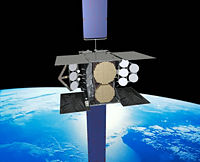Wideband Global Satellite: Difference between revisions
imported>Howard C. Berkowitz No edit summary |
imported>Howard C. Berkowitz No edit summary |
||
| Line 1: | Line 1: | ||
{{subpages}} | {{subpages}} | ||
A major increment in U.S. military satellite communications capability, '''Wideband Global Satellite (WGS)''' began operations, in its Block I version, in October 2007. | [[Image:Wideband Global Satellite.jpg|thumb|200px|left|Wideband Global Satellite orbiter]] | ||
A major increment in U.S. military satellite communications capability, '''Wideband Global Satellite (WGS)''' began operations, in its Block I version, in October 2007. Operating in the [[IEEE Frequency Bands|X- and Ka-bands]], these[[satellite orbits#geosynchronous orbit|geosynchronous satellites]] have approximately 10 times the bandwidth of their DSCS III (Defense Satellite Communications System) predecessors; the WGS can route between 2.1 and 3.6 Gbps of digital information. <ref name=BIDS-WGS>{{citation | |||
|title = Transformational Wideband Communication Capabilities for the Warfighter: WGS Mission | |title = Transformational Wideband Communication Capabilities for the Warfighter: WGS Mission | ||
| author = Boeing Integrated Defense Systems | | author = Boeing Integrated Defense Systems | ||
| Line 8: | Line 9: | ||
In November 2007, Australia joined the WGS program and provided funding to expand the WGS program to six satellites. | In November 2007, Australia joined the WGS program and provided funding to expand the WGS program to six satellites. | ||
==Past and present== | ==Past and present== | ||
WGS | WGS enhances and will eventually succeed, DSCS III, as well as the [[Global Broadcast Service]] function currently provided by UHF Follow-On satellites . In turn, the next generation, still in competitive design, is most often called the [[Transformational Satellite System]] (TSAT) constellation, which will use laser rather than radio links earth, but radio among the satellites. Launches are planned to begin in 2013, <ref name=GS-WINT-4>{{citation | ||
| url = http://www.globalsecurity.org/military/systems/ground/win-t-4.htm | | url = http://www.globalsecurity.org/military/systems/ground/win-t-4.htm | ||
| journal = Globalsecurity | | journal = Globalsecurity | ||
| Line 27: | Line 28: | ||
| url = http://www.gao.gov/new.items/d08467sp.pdf}}, pp. 173-174</ref> | | url = http://www.gao.gov/new.items/d08467sp.pdf}}, pp. 173-174</ref> | ||
==References== | ==References== | ||
{{reflist}} | {{reflist|2}} | ||
Revision as of 12:41, 4 February 2009
A major increment in U.S. military satellite communications capability, Wideband Global Satellite (WGS) began operations, in its Block I version, in October 2007. Operating in the X- and Ka-bands, thesegeosynchronous satellites have approximately 10 times the bandwidth of their DSCS III (Defense Satellite Communications System) predecessors; the WGS can route between 2.1 and 3.6 Gbps of digital information. [1] Two Block 1 satellites followed, procured, as firm-fixed price contracts for commercial equipment. The system, therefore, is also a demonstration of commercial telecommunications satellite engineering, although the project is also exploring military modifications.
Block 2 includes two satellites and an option for a third; Block 3 is under study. In November 2007, Australia joined the WGS program and provided funding to expand the WGS program to six satellites.
Past and present
WGS enhances and will eventually succeed, DSCS III, as well as the Global Broadcast Service function currently provided by UHF Follow-On satellites . In turn, the next generation, still in competitive design, is most often called the Transformational Satellite System (TSAT) constellation, which will use laser rather than radio links earth, but radio among the satellites. Launches are planned to begin in 2013, [2] although the project is still in a government-funded competitive proposal stage and operational funds have not been committed.
Project management and risk
WGS poses some unusual aspects of technological risk management, according to the General Accountability Office. At the time that Block I was deployed, it used COTS technology, with the low risk of methods already in service. Certain "critical technologies—the X-band phased array antenna system and digital channelizer—are no longer considered commercial items even though their design and configuration will not change for Block 2." The Air Force, indeed, enhanced on these technologies, for specific military requirements: "an upgrade that will allow ground controllers to direct two antennas to bypass the onboard channelizer for added airborne intelligence, surveillance, and reconnaissance support. Bypassing the channelizer will double the data transfer rate for those two channels. The WGS acquisition strategy indicates that the upgrade is low risk because the design and modification are within existing technology and contractor capabilities." Block 2 acquisition, beginning in February 2006, did not use commercial item procedures, but rather a "fixed price incentive fee contract for the Block 2 satellites that includes more reporting requirements such as earned value management data." [3]
References
- ↑ Boeing Integrated Defense Systems, Transformational Wideband Communication Capabilities for the Warfighter: WGS Mission
- ↑ "Transformational SATCOM (TSAT), Transformational Communications Satellite (TSAT), Advanced Wideband System", Globalsecurity
- ↑ General Accountability Office (March 2008), Defense Acquisitions: Assessments of Selected Weapon Programs., General Acountability Office Report [GAO-08-467SP], pp. 173-174
